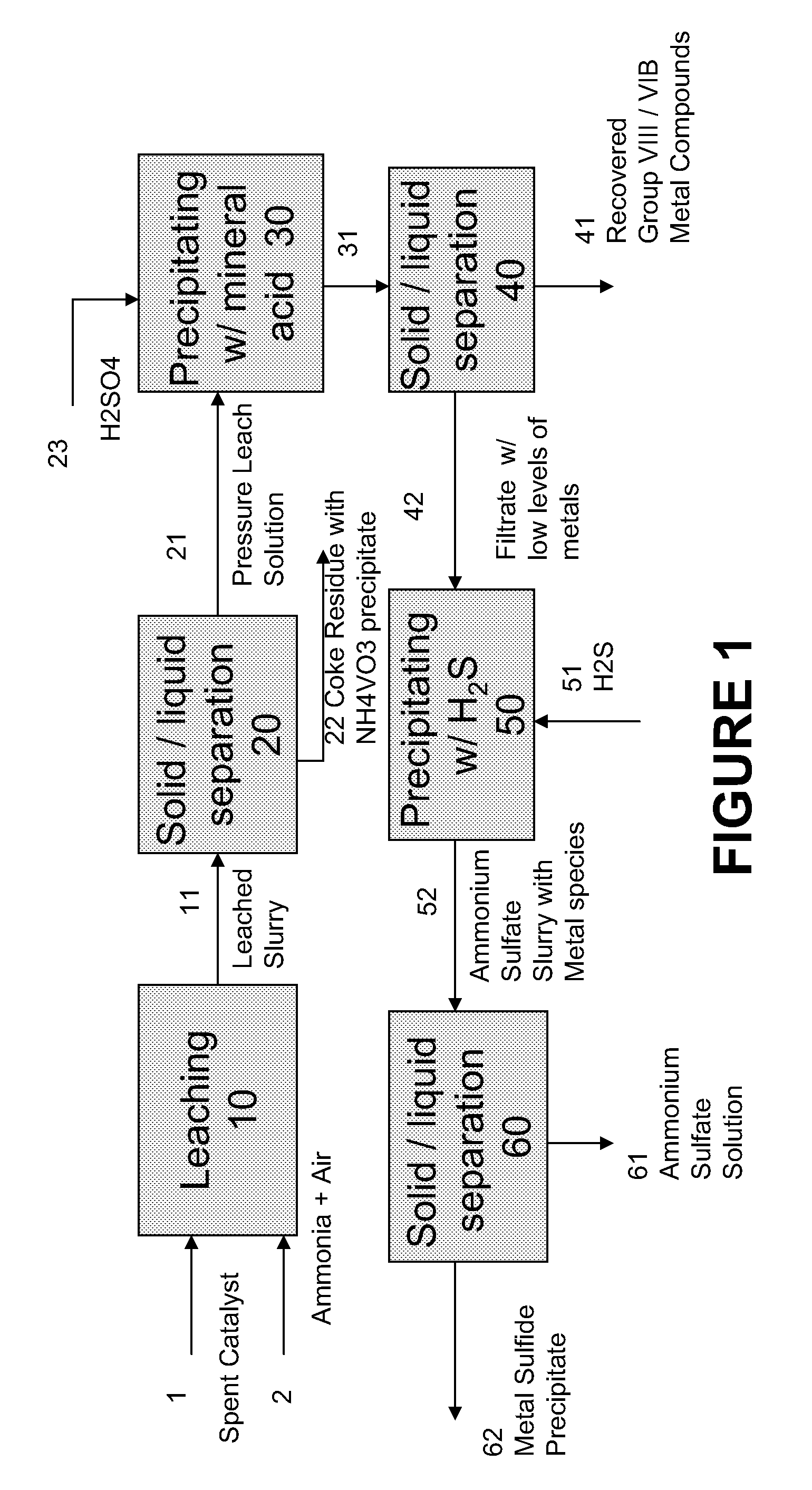Process for recovering base metals from spent hydroprocessing catalyst
a hydroprocessing catalyst and metal recovery technology, applied in the field of recovering metals from hydroprocessing catalysts, can solve the problem of huge quantities of spent catalysts generated by catalyst processes
- Summary
- Abstract
- Description
- Claims
- Application Information
AI Technical Summary
Benefits of technology
Problems solved by technology
Method used
Image
Examples
example 1
[0060]In this example, a PLS (deep blue color) stream with a pH of 9.2 was adjusted to 3.0 by single stage concentrated sulfuric acid (96%) addition. The PLS composition included 33 gpL free NH3, 80.9 gpL Mo, 7.9 gpL Ni, 0.17 gpL V and 277 gpL ammonium sulfate (Amsul). After mixing for about 2-hours at a temperature of 70° C., about 99% of the molybdenum precipitates out as a molybdenum compound. Approximately 98% of the residual Ni also precipitates out with the molybdenum. It is believed that the compound is a mixture of ammonium octamolybdate and nickel ammonium sulfate.
[0061]The slurry is cooled to ambient and filtered to remove the precipitate. The precipitate is optionally double-washed with pH 3.0 water at ambient temperature to remove entrained ammonium sulfate. During the washing step, an additional 23% of Ni re-solubilizes to achieve a final Ni recovery of about 75%. Minimal re-solubilization of Mo occurs. The final solution (including wash) analyzes 0.53 gpL Mo, 1.49 gpL ...
example 2
[0065]Example 1 is repeated with a PLS stream having a pH of 10.6, containing 53 gpL free NH3, 85 gpL Mo, 8.24 gpL Ni, 0.40 gpL V and 271 gpL ammonium sulfate (Amsul). The PLS stream pH is adjusted to 2.71. The final solution (including wash) shows 0.48 gpL Mo, 1.44 gpL Ni, and 0.08 gpL V, for a metal precipitation efficiency of 99.2% Mo, 77.3% Ni, and 75% V. The washed precipitated solids show a moisture of 25.9 wt %, 41.8 wt % Mo (dry basis), 3.37 wt % Ni (dry basis), 0.16 wt % V, 3.8 wt % AmSul, 2.76 wt % S and a Mo / Ni ratio of 12.4.
[0066]After sulfidation, the final Amsul stream concentration reveals 500 gpL Amsul, with 41 ppm Mo, less than 5 ppm Ni, and 26 ppm V.
PUM
| Property | Measurement | Unit |
|---|---|---|
| temperature | aaaaa | aaaaa |
| pH | aaaaa | aaaaa |
| pH | aaaaa | aaaaa |
Abstract
Description
Claims
Application Information
 Login to View More
Login to View More - R&D
- Intellectual Property
- Life Sciences
- Materials
- Tech Scout
- Unparalleled Data Quality
- Higher Quality Content
- 60% Fewer Hallucinations
Browse by: Latest US Patents, China's latest patents, Technical Efficacy Thesaurus, Application Domain, Technology Topic, Popular Technical Reports.
© 2025 PatSnap. All rights reserved.Legal|Privacy policy|Modern Slavery Act Transparency Statement|Sitemap|About US| Contact US: help@patsnap.com


